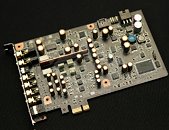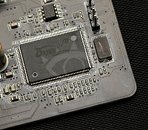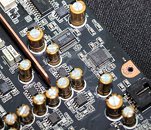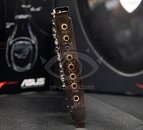Tuesday, January 10th 2012

ASUS ROG Phoebus Sound Card Pictured, Driven by New CMI Oxygen Express Chip
ASUS displayed its latest sound card, the Republic of Gamers (ROG) Phoebus. This card is designed for multichannel gaming audio. While it might not pack any fancy DSP that doesn't already exist, its AMP circuitry is so designed to give the best positional audio that could come handy with competitive online gaming. With this card, ASUS also brought to the fore C-Media's latest audio chipset, the CMI 8788DH Oxygen Express, which packs native PCI Express support. All PCI Express sound cards launched by ASUS so far feature OxygenHD and ASUS-rebadged AV-100 chipsets, that use legacy PCI, and hence depend on PCIe-to-PCI bridge chips by PLX to function on PCI Express.
The primary DAC for headphone/front-out channel of the ROG Phoebus is TI-BB PCM1792A, with stellar signal-noise ratio (SNR) of 127 dBA. Other main channels are handled by Cirrus Logic, probably the CS5381, with SNR of 120 dBA. There's also a tertiary Realtek ALC889 (110 dBA) CODEC that probably handles an independent set of audio channels, or handles the digital outputs, since it's licensed with a few Dolby technologies. On the AMP side, we spy bleeding-edge OPAMPs, a Texas Instruments 6120A2(?) AMP chip (for the headphones channel), etc.Many parts of the card are electrically isolated from the PCI Express slot, to prevent interference from the ground layer of the motherboard. So these parts rely on power drawn from a 6-pin PCIe power connector, conditioned by a tiny VRM. Only the power-conditioning parts of the card use solid-state capacitors, the AMP and audio parts use audiophile-grade electrolytic capacitors since by design they are better for analogue circuits. The whole card is topped off with a groovy-looking EMI shield. Expect this card to be costly.
Source:
VR-Zone
The primary DAC for headphone/front-out channel of the ROG Phoebus is TI-BB PCM1792A, with stellar signal-noise ratio (SNR) of 127 dBA. Other main channels are handled by Cirrus Logic, probably the CS5381, with SNR of 120 dBA. There's also a tertiary Realtek ALC889 (110 dBA) CODEC that probably handles an independent set of audio channels, or handles the digital outputs, since it's licensed with a few Dolby technologies. On the AMP side, we spy bleeding-edge OPAMPs, a Texas Instruments 6120A2(?) AMP chip (for the headphones channel), etc.Many parts of the card are electrically isolated from the PCI Express slot, to prevent interference from the ground layer of the motherboard. So these parts rely on power drawn from a 6-pin PCIe power connector, conditioned by a tiny VRM. Only the power-conditioning parts of the card use solid-state capacitors, the AMP and audio parts use audiophile-grade electrolytic capacitors since by design they are better for analogue circuits. The whole card is topped off with a groovy-looking EMI shield. Expect this card to be costly.





25 Comments on ASUS ROG Phoebus Sound Card Pictured, Driven by New CMI Oxygen Express Chip
Why no Molex? Because it's an old, ugly connector in its dusk.
though, I really do wish Asus would spend more time on their Audio drivers. They only really release a new driver once or twice a year and it doesnt matter if their new drivers are bugged or not they just make you wait until the next release :(
luckily, modded drivers are available and they are leagues ahead of Asus's the change log is like a 50 page essay on Astro Physics compared to Asus's own changes/updates.
I know it's not a power-circuit, but still...
you obviously do not know a whole lot about analogue circuits, many professional and top end audio equipments use electrolyte caps because they tend to sound more 'musical' (warm or tube-like) to the solid state caps.
Besides VRM areas, a PC motherboard doesn't really need solid caps in other parts. The vendors put them anyway, for PR reasons.Maybe because the rest of the rig is already pushing the PSU far, and the sound card is just putting it at its breaking point. There's no way a sound card draws over a dozen Watts. There's nothing on it that needs that much power.
Also gold painted electrolytic caps are easylier to explain for the marketing department. There are some green/blue/magenta ones that are much better.
Even if it makes no difference whatsoever.
LOGISYS AD201 12v Molex to 12V 6Pin Adapter
I, however, will still stick with an external DAC hooked up to onboard audio. Since I don't care about 5.1 or 7.1 sound that is the best solution for me, and you can get very good quality DACs for the price of high-end soundcards. If you really want surround a receiver and passive speakers, or a sound card such as this and active/powered speakers, are the way to go.